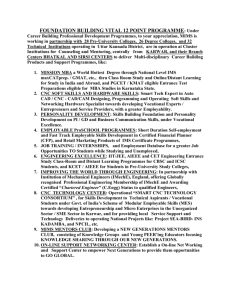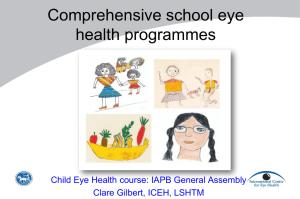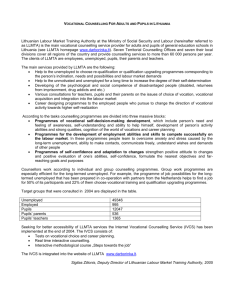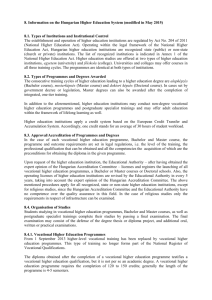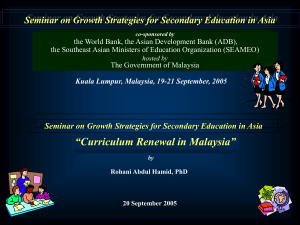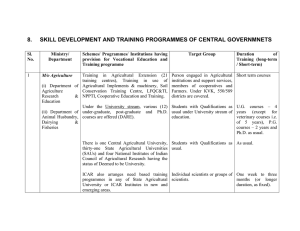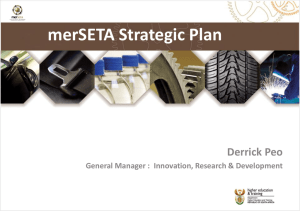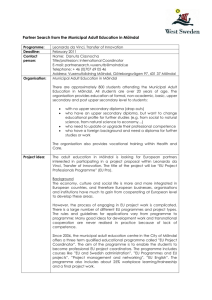SWOT analysis of school`s management
advertisement
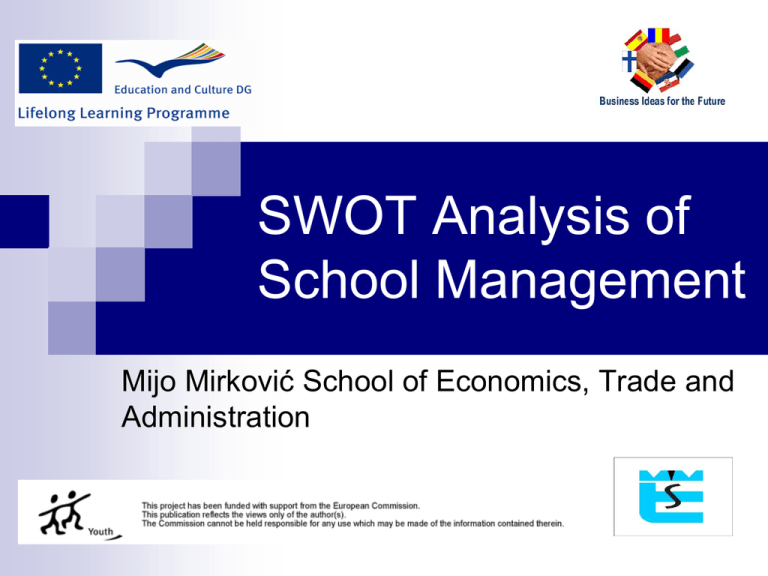
SWOT Analysis of School Management Mijo Mirković School of Economics, Trade and Administration Headmaster’s role – a brief intersection Organizational and pedagogical tasks staffing, coordinating the work of teachers, professional staff, shift leaders and other school employees, participation in the Parent and Student Council meetings analysis and monitoring of student success presenting educational programmes to the public preparation and conducting of the Teachers’ Council meetings, the Commission for the state graduation meetings, participation in the School Board meetings Financing and participation in cultural and public school activities planning, coordination and implementation of the financial plan equipping schools (technical literature, magazines, teaching aids, personal computers etc.) public procurement (collecting and analyzing offers concerning transportation of disabled children )-funded by Ministry of Education and Sports repairs and maintenance of the building (planning funds), employees professional development preparing and organizing competitions at the school, county and state level; organizing seminars and conferences which the school is the host for (professional inter-county council in the education sector of economy, trade and business administration) leadership and participation in projects (Comenius multilateral school partnerships, IPA-ECHO in collaboration with the High School of Economics Varaždin, ”The world in a palm of hand "- with International student organisation AIESEC, South East Mediterranean environmental project etc. organizing lectures and public discussions constant cooperation with Town and County Tourist Board and with Regional Development Agency “Porin”, humanitarian actions in school and beyond STRENGTHS 1.Programmes 2.Human resources 3.Cooperation with local community and Government bodies 4.Educating students with special needs 5.Growing interest for enrollment 6.Cooperation with parents Programmes and Human Resources Preferences: a) students can work after the graduation exam or b) continue their education at colleges (high turnout of students for the state graduation) foreign languages (English and German) and ICT skills enable application to different colleges constant monitoring and analysis of student success through Classroom sessions and the Teachers’ Council Meetings Teaching staff: programme improvement projects and competent teachers - (about one third of all teachers) represent an intellectual capital, those teachers have a motif for positive changes and team oriented work, they are focused on better achievements and results, the primary goal is to become more recognizable in the local community and at the state level Cooperation with local community and Government bodies cooperation with the Department for Education and Sports on County level, Ministry of Education and Sports, Agency for Education and Agency for Vocational Education on all matters related to: training, staffing, funding, planning and implementation of projects, as well as other issues concerning School local community suggests its representatives to the governing bodies of school (4 members in the School Board) and thus directly participate in decision-making on all important issues cooperation with the Department of Employment (especially related to adult education and programme adjustments according to labour market needs) Regional Development Agency “Porin” supports Entrepreneurship Education the school has its representative in the Sector Council at the Agency for Vocational Education (changes in programmes and enrollment policy) Educating students with special needs students may enroll in Administrative Official Programme since 1996/1997 and in Assistant Administrator Programme since 2006/2007 school has an architectural adaptation for those students (elevator, entrance, transport), medical care, physical therapists and special education teachers we are the only secondary school with over 30 students with special needs joint teaching and project work is organized with students from other classes to encourage individuality and creative potential for each student The role of parents in school life regular Teacher-Parent Meetings and School Sessions enable parents to be well informed on all relevant issues a parent representative of the School Council is elected each year to the School Board and directly involved in management and decision making WEAKNESSES 1. centralised school system - prescribed curriculum 2. financing (reduced inflow of funding for building maintenance, project funding by County, reduced self-financing from grants) 3. teaching staff class organization 4. School System and Financing School system: strictly prescribed curriculum (number of hours) and programme (content) per subject professional development of teachers of the same area or profession is organized by the Agency for Education and Vocational Education Agency inadequate exchange of information and teaching material among teachers in different counties/schools Financing : from state budget (payments) and local authorities (building maintenance etc.), other resources depend on the headmaster (project involvement and donations-grants) limited resources and funds have direct impact on acquisition of new equipment and teaching aids donations from individual and/or small companies partially cover costs related to certain activities like: issuing the school magazine, anniversaries, seminars etc. Teaching staff-what is missing? This refers to a group of teachers: lack of pedagogical and psychological education which affects teaching, therefore has direct influence on class absence lack of interpersonal skills (unadjusted to changes) fear of new teaching methods computer illiteracy - some teachers don’t know how to use a PC or don’t want to unconcern (there is no legal obligation to monitor educational legislation, there is no personal responsibility) lack of modern business ideas and enthusiasm Classes in shifts due to a large number of students and teachers (854 students + 74 teachers), classes are organized in two shifts: the first from 8.00 to 13.15 and the second from 13.15 to 19.20 the building dates from 1858, adjusted for education after the World War I almost all the classrooms and cabinets are occupied in both shifts, so there isn’t too much space for creative work (extracurricular activities, work on projects etc.) OPPORTUNITIES 1. introduction of new curricula and programmes 2. knowledge and technology transfer - modernization of the educational system and its adaptation to the EU 3. use of pre-accession funds (IPA) equipping schools 4. involving the wider community in creating a business school policy 5. strengthening the recognition and identity of School Creating a new vocational curriculum and the introduction of new occupations working together with the Croatian Employment Service, Ministry of Education and Sports and the Agency for Vocational Education to modernize and adapt programmes to labour market needs facilitate transfer of technology and knowledge - align our education system and qualifications framework to those in the EU countries provide a better vertical mobility and employability of young people in the country and beyond Working on projects, use of the Pre-Accession Assistance funds (IPA) and equipping schools motivate more teachers to turn in project work use available resources of the Agency for Mobility and the EU programmes and plan new projects under the Comenius, Leonardo da Vinci get involved in the development of the IPA projects, especially component IV- Human resource development and thus part of the funds spent on furnishing and equipping school Enhancing school identity regular informing of the public about the activities (updating the school website, publishing an article in the press, address to local TV stations) strengthening the role of the county School Board members in decision making and creating business school policy develop new projects, increase interest in student enrollment THREATS unfavourable business environment (possible lack of enrollment quotas or termination of certain programmes due to poor employability) the consequence – a part of employees becomes redundant administrative barriers, lack of entrepreneurial spirit by some teachers and lower-financing obstacles lack of specific knowledge and insufficiently trained staff can significantly reduce the interest in school / programmes and lead to poor educational results compensation system and lack of motivation may cause drain of professional and highly motivated staff in other professions/areas

